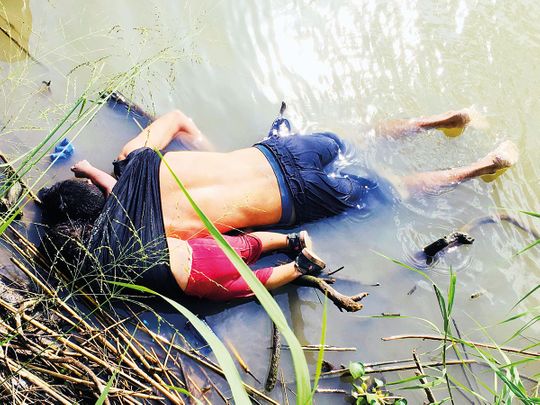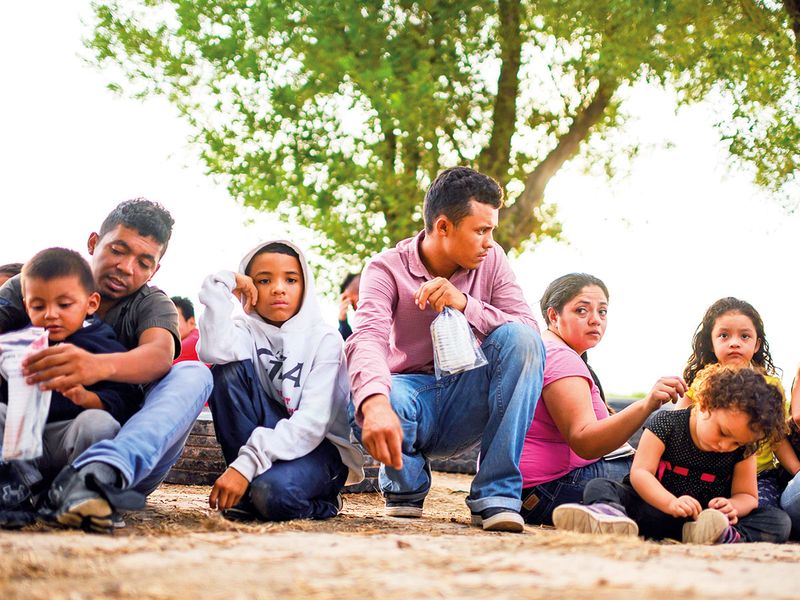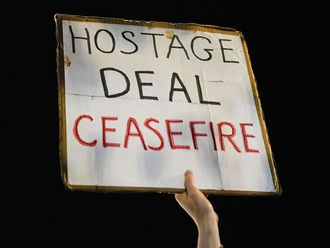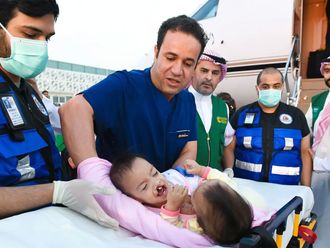
MEXICO CITY: The father and daughter lie facedown in the muddy water along the banks of the Rio Grande, her tiny head tucked inside his T-shirt, an arm draped over his neck.
The portrait of desperation was captured on Monday by journalist Julia Le Duc, in the hours after Oscar Alberto Martinez Ramirez drowned with his 23-month-old daughter, Valeria, as they tried to cross from Mexico to the United States.
The image represents a poignant distillation of the perilous journey migrants face on their passage north to the United States, and the tragic consequences that often go unseen in the loud and caustic debate over border policy.
It recalled other powerful and sometimes disturbing photos that have galvanised public attention to the horrors of war and the acute suffering of individual refugees and migrants - personal stories that are often obscured by larger events.
Like the iconic photo of a bleeding Syrian child pulled from the rubble in Aleppo after an airstrike, or the 1993 shot of a starving toddler and a nearby vulture in Sudan, the image of a single father and his young child washed up on the Rio Grande’s shore had the potential to prick the public conscience.
As the photo spread on social media, Democrats in the House were moving toward approval of an emergency $4.5 billion humanitarian aid bill (see story on right) to address the plight of migrants at the border.
Representative. Joaquin Castro, Democrat-Texas, the chairman of the Hispanic Caucus, grew visibly emotional as he discussed the photograph in Washington. He said he hoped that it would make a difference among lawmakers and the broader American public.
“It’s very hard to see that photograph,” Castro said. “It’s our version of the Syrian photograph - of the 3-year-old boy on the beach, dead. That’s what it is.”
The desperate hopes of Oscar Alberto Martinez Ramirez
The young family from El Salvador - Martinez, 25, Valeria and her mother, Tania Vanessa Avalos - arrived last weekend in the border city of Matamoros, Mexico, hoping to apply for asylum in the United States.
Martinez’s wife, Tania Vanessa Avalos, said that they had been waiting at a camp in Matamoros, on the Mexican side of a bridge that connects the city to Brownsville, for two months to present their asylum claims to United States officials. On Sunday, they decided to cross the river on their own. But the international bridge was closed until Monday, officials told them, and as they walked along the banks of the river, the water appeared manageable.
The family set off together around mid-afternoon Sunday. Martinez swam with Valeria on his back, tucked under his shirt. Avalos followed behind, on the back of a family friend, she told government officials.
Martinez had taken his daughter in his arms, crossed the river and put her on dry land, Avalos said. When Martinez went back for his wife, she said, Valeria jumped into the water. When he tried to rescue her, both were pulled under.
But as Martinez approached the bank, carrying Valeria, Avalos could see he was tiring in the rough water. She decided to swim back to the Mexican bank.
Back on the Mexico side, she turned and saw her husband and daughter, close to the American bank, sink into the river and get swept away.
On Monday, their bodies were recovered by Mexican authorities a few hundred yards downstream, fixed in the same haunting embrace.
La Jornada, a newspaper based in Mexico City, identified the migrants in the photograph as Oscar Alberto Martinez Ramirez and his daughter Valeria, from El Salvador.
Ávalos said that she alerted the authorities, and that a search began. The authorities found the bodies about 12 hours later, about 550 yards away from where they sank.
When asked about the photograph, President Andres Manuel Lopez Obrador of Mexico said it was “very regrettable that this would happen,” according to The Associated Press.
“I know our hearts can’t take more,” Rep. Veronica Escobar, D-Texas, said on Twitter. “We must keep fighting for the dignity & humanity of these vulnerable souls.”
Members of the family issued a plea to the public on Tuesday, seeking money to help repatriate the bodies of Martinez and Valeria. The cost was expected to be about $8,000 - an unimaginable sum for the relatives to manage.
Hours later, the government agreed to cover the costs.
Crossing the Rio Grande: the deadly journey

Crossing the Rio Grande has long been one of the many deadly hurdles migrants face as they try to enter the United States.
Migrants from Central America have crossed the border by the thousands in recent months, overwhelming Border Patrol agents, nonprofit groups and local officials.
The surge has shown how deadly the journey can be, both in the Rio Grande and beyond. Harsh desert conditions and a lack of water spur dehydration or heat stroke.
Many migrants cannot swim, and Border Patrol agents said this month that they were pulling dozens of migrants, including children, from the river almost every day.
From Oct. 1 to early June, Border Patrol agents rescued at least 315 migrants from a 209-mile stretch of the Rio Grande - up from 12 migrants the year before.
But there have also been tragedies.
In May, a 10-month-old boy died after a raft carrying migrants overturned on the Rio Grande.
In Hidalgo County, on the border, sheriff’s officials reported 27 migrant waterway deaths last year, an increase from 13 in 2017.
Deterrence: a strategy under a cloud
Deterrence has been a favoured strategy among US officials seeking to stem the tide of migration, even before President Donald Trump took office.
Under sustained pressure from Trump, Mexico has been stepping up its own migration enforcement in recent months.
This effort accelerated in the past two weeks as part of a deal the Lopez Obrador administration struck with Washington to thwart potentially crippling tariffs.
As of Monday, the Mexican government had deployed more than 20,000 security forces to the southern and northern borders to try to impede the passage of unauthorized migrants toward the United States, officials said.
But human rights experts, immigrants’ advocates and security analysts warned that the mobilisation could drive migrants to resort to more dangerous routes in their effort to reach the United States.
But for every migrant who chooses to take the journey, whether on foot, packed into cargo trucks or on the top of trains, the fear of what lies behind outweighs that which lies ahead.
Agencies








